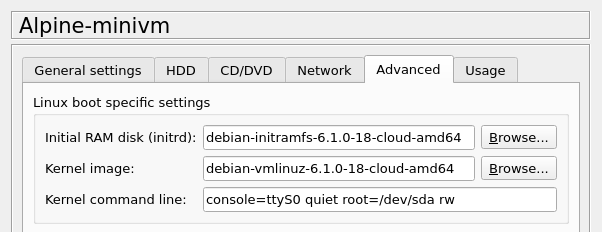While I like the simplicity and performance of Docker VMs, they have some drawbacks when used within GNS3:
- Persistence - Only the persistent directories will be saved. Additionally installed software will be lost after restart.
- Host kernel - The Docker VM can only use the features available in the host kernel.
- Security - The isolation between the Docker VM and the host is not as good as with QEMU VMs.
Looking for a way to make QEMU VMs lighter and easier to setup,
I found this article:
Execute Docker Containers as QEMU MicroVMs
Sad enough the use of QEMU MicroVMs is not possible in GNS3.
GNS3 doesn't offer the virtio-blk-device and virtio-net-device devices.
Instead of extending GNS3 I used the concept with normal QEMU VMs.
Booting is not as fast as with MicroVMs, but 1-2 seconds boot time
is perfectly acceptable.
The MiniVM is split into several parts, the kernel components and the root disk image.
The kernel consists of the kernel image, an initial RAM disk and an optional module disk image. The kernel can be used for all of the appliances - it only needs to be built once.
QEMU will directly boot the kernel, without the use of a boot loader. In GNS3 this is configured in the advanced tab of the appliance template.
For more information see the kernel directory.
The root image is a converted Docker image, so first we need to create that.
The Docker context directory is a fairly standard one,
for an example see the alpine-minivm directory.
Only the etc subdirectory contains additional files
normally provided by Docker but not by QEMU.
Additionally it needs etc/acpi/PWRF/00000080, which is run on ACPI poweroff.
Besides these etc files the QEMU VM needs an init program.
I include a modified version of the init from the MicroVM article.
Now we need to build the Docker VM and do some initial tests.
Then the Docker image needs to be converted to QCOW2 and the
init program added, this is done by the docker2qcow2 script.
If something goes wrong with your VM and you can't access it in the normal way, it's good to have fallback methods. As with "normal" Linux VMs, you can add special parameters to the kernel command line:
single- This will open a shell in the initial RAM disk, just before the root disk is mounted. Exiting this recovery shell resumes the normal boot sequence.init=/bin/sh- This runs a shell after the initial RAM disk has been run, so that the root disk is mounted. This is useful if the/etc/init.shscript contains a fatal error.
The recovery shell can't be stopped in the normal way.
Instead, a forced shutdown must be performed
by running sync then poweroff -f.
By importing the *.gns3a appliances you can directly use them in GNS3.
